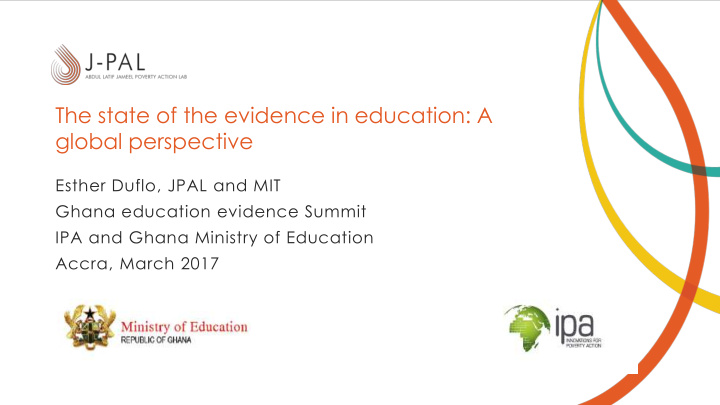



The state of the evidence in education: A global perspective Esther Duflo, JPAL and MIT Ghana education evidence Summit IPA and Ghana Ministry of Education Accra, March 2017
Achieving Education Goals
Education: focus on quality & learning in SDGs vs MDGs Millennium Development Goals Sustainable Development Goals Net primary enrollment in • developing countries 91% in 2015 J - PAL | STRATEGIES FOR ACHIEVING SDGS IN EDUCATION AND HEALTH 3
Enrollment gains stunning but attendance often lags In poorest countries education has gone from the exception to the rule • in a single generation, an extraordinary achievement Number of children in primary school in SS Africa more than doubled from – 1990 to 2015 In most countries more days lost to infrequent attendance than failure • to enroll We know a lot from RCTs about how to increase enrollment and • attendance Small reductions in cost – eg free school uniform – Information on the costs and benefits of education – 10 cent deworming pill – Surprising that such small changes can have big effects given the • magnitude of the investment of time and effort in education J - PAL | STRATEGIES FOR ACHIEVING SDGS IN EDUCATION AND HEALTH 4
The new access issues Secondary education • Much lower than primary in most countries, although fast progress as well – Barriers are: – Achievement • Cost • Evidence is limited, although major experiment in Ghana shows secondary – school completion increased by 26 percentage points (from 47.5% to 83.5%)when children who had qualified, but did not initially attend for lack of fund were offered a scholarship Early Childhood program • RCT In Mozambique finds that pre-school in village leads to increase in For – example, in one recent randomized trial in Mozambique, access to preschool increased children’s primary school enrollment, fine motor skills, and problem solving, but not their later language development Need for more research on what constitute quality ECD (in terms of – preparation for primary): existing experiment largely disappointing. J - PAL | STRATEGIES FOR ACHIEVING SDGS IN EDUCATION AND HEALTH 5
A learning challenge in developing country schools Sabarwal, Evans, and Marshak, 2014 Rolleston 2015 Sierra Leone: Numeracy levels in 350 Andhra Pradesh (India): 12 year olds disadvantaged schools in 5 randomly performed less well on math tests in 2013 chosen districts than in 2006 J - PAL | STRATEGIES FOR ACHIEVING SDGS IN EDUCATION AND HEALTH 6
Why is learning so limited in developing countries? J - PAL | STRATEGIES FOR ACHIEVING SDGS IN EDUCATION AND HEALTH 7
Relative cost-effectiveness of education programs • All results from randomized trials • All result are standardized to unit-free measure (SD) • Cost-effectiveness measured in SDs per $100 – 1SD per $100 is very good value for money J - PAL | STRATEGIES FOR ACHIEVING SDGS IN EDUCATION AND HEALTH 8
Access can increase learning J - PAL | STRATEGIES FOR ACHIEVING SDGS IN EDUCATION AND HEALTH 9
Business-as-usual inputs d on’t work J - PAL | STRATEGIES FOR ACHIEVING SDGS IN EDUCATION AND HEALTH 10
School-based management is hard J - PAL | STRATEGIES FOR ACHIEVING SDGS IN EDUCATION AND HEALTH 11
Changes in pedagogy are key J - PAL | STRATEGIES FOR ACHIEVING SDGS IN EDUCATION AND HEALTH 12
Teacher accountability matters J - PAL | STRATEGIES FOR ACHIEVING SDGS IN EDUCATION AND HEALTH 13
Results highlight underlying structural issues Much spending is on teachers and • standard inputs Very heterogeneous levels of learning • Curricula of often way above head of • poor children Teachers are not accountable • Teachers teach to the top of the class • Disadvantaged children fall further and • further behind Pratham’s numeracy interventions J - PAL | STRATEGIES FOR ACHIEVING SDGS IN EDUCATION AND HEALTH 14
Conclusion: Highlights for Ghana At the primary level, key challenge is to improve learning outcomes • Changing Pedagogy to Teach at the Right Level – Children can learn and we do know the tools (see Annie Duflo’s – presentation later): it is a matter of signaling to teachers that it is the priority. Thinking about pre-primary as a way to reduce heterogeneity in • learning level at the onset of primary: Expose children to materials that can help them build on their own – naturally developing capacity Access to Secondary education: • Financial barrier are important – Impacts on cognitive scores, fertility, tertiary, labor markets – 15
The Impact of Free Secondary Education: Experimental Evidence from Ghana Scholarships awarded by lottery among 2,064 • Ghanaian students (aged 17 on average), tracked to age 25+. Scholarship winners: • Scored higher on a math and reading – comprehension test. Were more likely to attend tertiary – education (especially women) Women were 10.7 percentage points (or – 18%) less likely to have ever been pregnant, significantly less likely to have ever lived or cohabited with a partner, and had .217 fewer children. Were 5.5 percentage points (10%) more – likely to have positive earnings and had significantly higher earnings on average 16
Recommend
More recommend